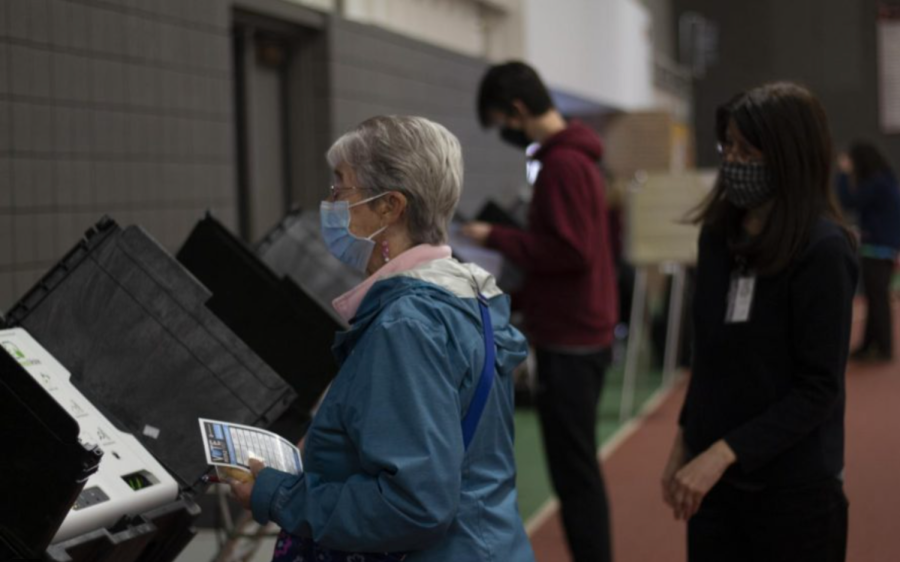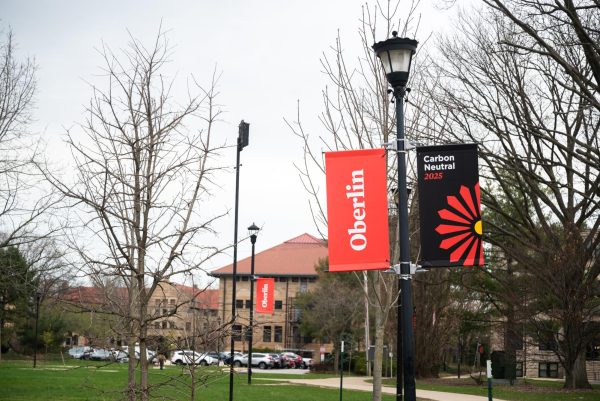Committee Misses Court Deadline, New Districts Remain Uncertain
Students and community members vote at the Heisman Club Field House in the 2020 election.
The Ohio Redistricting Commission failed to meet a deadline last week to produce fair legislative maps as ordered by the Ohio Supreme Court. With the Ohio primary elections scheduled for May 3, uncertainty regarding congressional districts has created challenges for candidates and voters alike.
The Ohio Redistricting Commission was created as the result of a 2015 Ohio state constitutional amendment to address gerrymandering. The amendment was passed in a vote that garnered nearly 75 percent of popular support for the creation of the commission.
“I was very optimistic when the constitutional amendment was passed,” said Head of the Science Library and member of the League of Women Voters Alison Ricker. “People were so, so excited and thought, ‘This will do it! The bipartisan commission will be wonderful and will work together.’ And they just didn’t. … We worked so hard to get signatures and get it on the ballot. And we were really talking about how it was going to improve politics in Ohio and we really believed it would.”
The road to producing fair congressional maps after the 2020 census has been anything but smooth. After the Ohio Redistricting Commission produced a set of maps in September, a number of lawsuits arguing that the maps did not meet constitutional requirements to fairly represent the residents of Ohio were filed in the Ohio Supreme Court.
“I think what we’re seeing here is the growing pains of some folks in politics who really don’t want to let go of partisan gerrymandering, and they’re trying to see if they can still get away with it,” said Associate Professor of Geology and Oberlin College Votes member Zeb Page. “And that’s frustrating because I think that there are some groups that are really trying to get away with as much as they can.”
After numerous back-and-forths between the court and the commission, the court ruled that the commission would need to produce constitutional maps by Feb. 17. Last week, the commission failed to meet this deadline, so the court gave the members until Wednesday to explain why they should not be held in contempt of the court.
On Tuesday, all seven members of the commission will appear in court to defend their choice to miss the deadline. “The court ordered them to submit a map and they blatantly disregarded the court’s order,” said Oberlin City Council Member Bryan Burgess. “And what does that mean? Will the Supreme Court order the members of the commission to be jailed? Fined? Who would impose those punishments? What happens when the executive and legislative branches refuse an order from the Supreme Court? We’re in uncharted territory. No one knows what’s gonna happen.”
It is unlikely that any one of the seven members of the commission, which includes Ohio Governor Mike DeWine, will be jailed, but the maximum penalty for a first offense of contempt of court is a $250 fine and up to 30 days in jail.
The extended back-and-forth between the Ohio Supreme Court and the Commission has created challenges for the upcoming May 3 primary. On Tuesday, Secretary of State Frank LaRose wrote to the Ohio Redistricting Commission to warn members that the May primary would not be able to go forward without a completed map. LaRose himself is a member of the Ohio Redistricting Commission.
The limbo state of the map makes it uncertain which district will include Oberlin. In previous elections, Oberlin was part of the Ohio 4th Congressional District, held by Jim Jordan; the 56th State Congressional District, held by Joe Miller; and Ohio Senate District 13, held by Nathan Manning.
Maps that were passed this fall and later struck down by the Ohio Supreme Court changed some of the boundaries for Oberlin’s U.S. and state districts. Oberlin was moved out of Democrat Joe Miller’s district; in response local city council member Bryan Burgess decided to run for Ohio House against Republican incumbent Dick Stein in the 53rd District.
“The second map that [the commission] submitted showed Oberlin being out of the traditional district that we’ve been in for decades,” Burgess said. “Oberlin has often been in the same district as other cities and central Lorain County and the new map that they drew pulled Oberlin out of that district and put it into Southern Lorain
County and further west into Huron and Erie counties.” As the maps have yet to be finalized due to current litigation, the boundaries for the district Burgess is running in are not yet finalized. Nonetheless, the filing deadline to run was Feb. 2, so Burgess filed in the 53rd District even though future maps could put Oberlin in a different district.
“Candidates across the state of Ohio filed to run in a district,” Burgess said. “Those districts are up in the air, they’re undefined. They may not even exist on the next map that gets approved. And so even though I’ve filed in the 53rd, Oberlin may not be in the 53rd District on the next approved map.”
The chaos of the redistricting has also caused confusion for voters who are uncertain what the boundaries of their district are or what candidates they will be voting for this spring. Nonetheless, Page urges voters, especially students, to focus on things they can control while they wait, like getting registered to vote.
“I think it’s less important to focus on the details of what the ultimate congressional districts will be, but to remember that participating is important,” Page said. “And although there’s not that much we can do right now about what congressional district or legislative district that we will be in Oberlin, we can make sure that we’re ready to participate.”
Despite the uncertainty created for voters and candidates like Burgess, the month-long legal fight could result in more democratic maps that better represent the residents of Ohio.
“I think [having a fair map] is a reasonable hope,” Ricker said. “I think that we’re not gonna be left with the really gerrymandered map that the Republicans came up with. I mean, some parts of the state will seem pretty gerrymandered possibly, but there’s some really glaring problems, especially down around Cincinnati that were really obvious gerrymanders.”
The deadline to register to vote in the Ohio primary is April 4. Students interested in helping with voter registration can reach out to OC Votes at OCvotes@ oberlin.edu.







